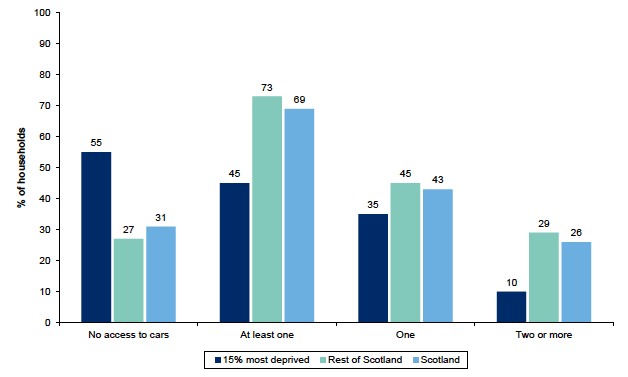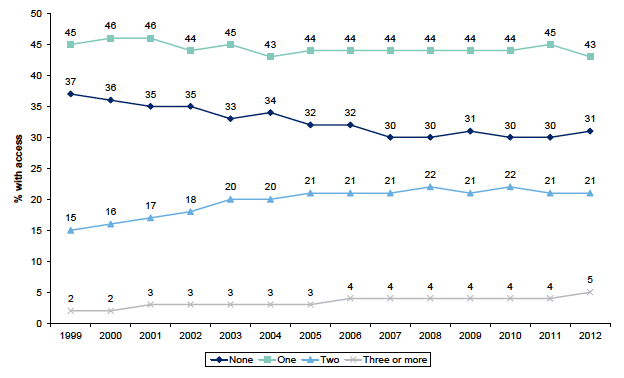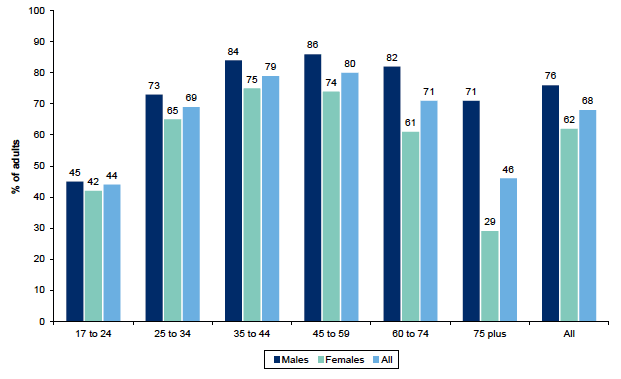Scotland's People Annual Report: Results from 2012 Scottish Household Survey
A National Statistics publication for Scotland, providing reliable and up-to-date information on the composition, characteristics, behaviour and attitudes of Scottish households and adults across a number of topic areas including local government, neighbourhoods and transport.
8 Transport and Travel
Introduction and context
An efficient transport system is essential to Scotland's economy, communities, environment, health and general well-being. Transport is important to everybody in Scotland, allowing them to reach workplaces or schools, have access to shops or services, visit friends and family and enjoy leisure services. Improving transport and the associated transport choices in Scotland plays an important role in achieving the Scottish Government's overall Purpose:[59] to focus Government and public services on creating a more successful country, with opportunities for all of Scotland to flourish, through increasing sustainable economic growth.
Two key transport National Indicators that are used to measure Government progress use Scottish Household Survey (SHS) data are: reduce traffic congestion; and, increase the proportion of journeys to work made by public or active transport.
Transport Scotland publishes the SHS transport and travel data directly.[60] The Transport and Travel in Scotland publication includes information on households' access to cars and bikes, frequency of driving, modes of travel to work and school (including an update to the National Indicator), use and opinions of public transport and access to services. The SHS Travel Diary publication provides information about travel by adults, including journey purposes and the means of transport used amongst others, as well as an update to the congestion National Indicator.
The SHS also provides a range of other transport-related information that can be used to understand travel patterns and choices across Scotland as well as monitoring progress on Scotland's Transport Strategy.[61] This sets out current policy which aims to improve journey times and connections, reduce emissions, and improve the quality, accessibility and affordability of transport. This chapter focuses on the number of cars available to households and possession of driving licenses.
Main Findings
- Just under seven-in-ten (69%) of households have a car available for private use, with those living in rural areas more likely to own at least one car (83% in remote rural areas compared to 59% in large urban areas).
- Car availability is strongly associated with income: in those households with a net annual household income of over £40,000 almost all households (98%) have access to at least one car, whilst at least half of households with an income of £15,000 or below do not have access to a car at all
- There has been a period of relative stability in the number cars households have access to, though 2012 estimates suggest a slight increase in the number of households with access to three or more cars (5%).
- Just over two thirds (68%) of adults hold a full driving licence, with a higher proportion of males (76%) compared to females (62%) - the proportion of females represents a two percentage point increase from 60% in 2011.
Cars and Driving
Access to cars
Overall, seventy per cent of households in Scotland have access to at least one car (Table 8.1). However, this varies depending on a number of factors, such as the type of area an individual resides, or their level of income. Four-in-ten (41%) households in large urban areas do not have access to a car compared to less than one-in-five of households in rural areas of Scotland. Those households in rural areas are also more likely to have access to a larger number of cars, with 44% of households in accessible rural areas having access to two or more cars - though of interest is that this drops to 35% for those living in remote rural areas. This differences may be due to less frequent/direct public transport services that are available in rural areas, though also perhaps a reliance on other forms of transport.
Table 8.1: Number of cars normally available to the household for private use by Urban Rural Classification
Column percentages, 2012 data
| Households | Large urban areas | Other urban | Small accessible towns | Remote small towns | Accessible rural | Remote rural | All |
|---|---|---|---|---|---|---|---|
| No access to cars | 41 | 30 | 23 | 31 | 14 | 17 | 31 |
| At least one | 59 | 70 | 77 | 69 | 86 | 83 | 69 |
| One | 41 | 43 | 47 | 49 | 42 | 48 | 43 |
| Two or more | 18 | 27 | 30 | 20 | 44 | 35 | 26 |
| Base | 3,520 | 3,230 | 960 | 620 | 1,150 | 1,160 | 10,640 |
Car availability is also strongly associated with income; the higher a household's income the higher likelihood it will have access to at least one car. Indeed, in those households with a net annual household income of over £30,000 over nine in ten households have access to at least one car. Ninety eight per cent of households with an income greater than £40,000 have access to at least one car. In contrast, at least half of households with an income of £15,000 or below do not have access to a car at all. This means that fewer households from groups with below average income levels (such as single adults/parents/pensioners) have access to a car.
Table 8.2: Number of cars normally available to the household for private use by net annual household income
Column percentages, 2012 data
| Households | £0 - £6,000 | £6,001 - £10,000 | £10,001 - £15,000 | £15,001 - £20,000 | £20,001 - £25,000 | £25,001 - £30,000 | £30,001 - £40,000 | £40,001+ | All |
|---|---|---|---|---|---|---|---|---|---|
| No access to cars | 61 | 64 | 51 | 37 | 21 | 13 | 7 | 2 | 30 |
| At least one | 39 | 36 | 49 | 63 | 79 | 87 | 93 | 98 | 70 |
| One | 30 | 31 | 40 | 53 | 57 | 55 | 47 | 29 | 43 |
| Two or more | 9 | 5 | 9 | 10 | 22 | 32 | 46 | 69 | 27 |
| Base | 310 | 1,150 | 1,960 | 1,620 | 1,350 | 990 | 1,320 | 1,560 | 10,260 |
Household income in the SHS is that of the highest income householder and their partner only. Includes all adults for whom household income is known or has been imputed. Excludes refusals/don't know responses.
There are clear links between access to a car and the level of deprivation of an area which are shown in Figure 8.1. Forty five per cent of households in the 15% most deprived areas of Scotland[62] have at least one car available to them compared with around three-quarters (73%) in the rest of Scotland. This difference is more pronounced when looking at households with two or more cars; one-in-ten households (10%) in the 15% most deprived areas have two or more cars available to them compared with almost three-in-ten (29%) in the rest of Scotland. Part of the reason behind these findings will be the link between multiple deprivation and the urban rural classification, i.e. most areas in the 15% most deprived are urban areas.
Figure 8.1: Number of cars normally available to the household for private use by Scottish Index of Multiple Deprivation
2012 data, Households (base: 10,640; minimum: 1,510)

Figure 8.2 shows the changes in car availability over time. Over the last decade the proportion of households having no access to a car had declined steadily - 37% of households in 1999 did not have access to a car compared to 30% in 2007 from which the figure has remained relatively stable through to 2012. Those households with access to just one car has remained relatively stable over the past decade, particularly since 2005 when it has remained at around 44% though there has been a decrease to 43% in 2012. In contrast there has been a general increasing trend of households with access to a larger number of cars, with those with access to two cars increasing from 15% in 1999 through to a high of 22% in 2010. Those with access to three or more cars increased by one percentage point to 5% in 2012 (had been 4% for the previous six years).
This demonstrates that the overall increase in the number of cars on Scotland's roads has arisen from a widening of availability of access to more households coupled with an increase in multi-car ownership. Though at the same time, the slight downturn in 2011 in multi-car households does suggest financial pressures as evidenced in chapter 6 may be making an effect on how many cars households can afford to run.
Figure 8.2: Household car access by year
1999-2012 data, Household (2012 base: 10,640)

Driving licences
As Figure 8.3 shows, just over two-thirds (68%) of adults hold a full driving licence with a higher proportion of males (76%) holding a licence as compared to females (62%) - the proportion of females represents a two percentage point increase from 60% in 2011. The percentage with a full licence peaks for females within the 35 and 44 age group (75%) and for males between the ages of 45 and 59 (86%). There are significant differences between driving licence possession amongst most age groups for males and females, however these are most pronounced in those aged 60 and over. Around 29% of females aged over 75 have a licence compared with 71% of males.
Figure 8.3: Adults who hold a full driving license by gender within age
2012 data, Adults aged 17 and over (base: 4,380; minimum: 340)

Contact
Email: Nic Krzyzanowski
There is a problem
Thanks for your feedback